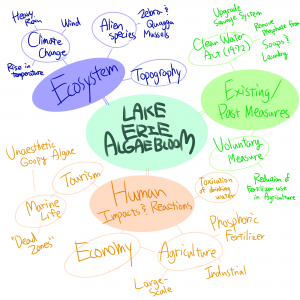In recent years, the algae bloom in the US Great Lake, most manifestly seen in Lake Erie, has rapidly expanded their territory. Reported cases of drinking water becoming toxic from high level of microcystin and large-scale deficiency of oxygen leading to reduction of marine life is becoming a serious concern. This mind map aims to deconstruct the multiple dimensions of this biological and human induced “wicked problem” to gain a scope of this phenomenon.
The mind map mainly highlights on the possible causes of the problem, as well as measures already taken in the past and the consequences brought by the algae bloom.
The problem is not as simple as it seems; levels of phosphate washed down from agricultural lands are the main nutritional foundation for the algae, so reduction of the run-off of fertilizers would be a logical, science-based solution. However, as this is a “wicked” problem, the simple scientific solution cannot possibly eliminate the multiple causes of this case. Wicked problems consist of two uncertainties: Scientific and value-based. The algae bloom problem indeed includes uncertainties and unknown factors in both of these dimensions.
In the scientific side of this problem, the causes are not only the phosphate levels. As written in the mind map, the introduction of alien species – namely the Zebra and Quagga mussels have contributed to the increase of algae levels. Their diet do not include the blue algae in the lakes, and so cannot act as a stopper of the plant. Also, the climate change in recent years have risen the temperatures of the water and atmosphere, accelerating the algae bloom, along with the heavy rain that increases run-off of fertilizers. These ecological conditions complexly intertwine and lead to difficulty in pointing to a fundamental solution even in scientific terms.
It could be said that the negotiations of values could be a more complex dimension. The current measures taken by the government only consists of voluntary measures, asking the agricultural institutions to reduce their use of phosphates in response to the pressures from environmental institutions. Though there are benefits for farmers to cooperate in this environmental movement, the expected economic loss from inefficient agriculture has not been helpful in reducing the amount of fertilizer use. As much as the local residents are relying on the Great Lakes as an important source of water and values it as a tourism site, the agricultural field sustains the state economically, and forceful regulations will lead to negative consequences. However, the algae bloom will not have an positive impact on the agricultural industry either, considering that the great lakes are the water source for irrigation.
In this wicked problem, the key is to explore a possible solution that considers both the interests of the public and the agricultural industry, as well as carefully examining the several ecological conditions affecting the rise in algae levels.
References
Roelofs, Ted. ‘Bridge : Algae Bloom, The Sequel, Spells Big Trouble For Lake Erie’. Bridgemi.com. N.p., 2015. Web. 25 Sept. 2015.
Torregrossa, Mark. ‘Harmful Algae Bloom Now Starting To Form In Lake Erie’. MLive.com. N.p., 2015. Web. 25 Sept. 2015.

